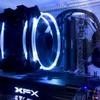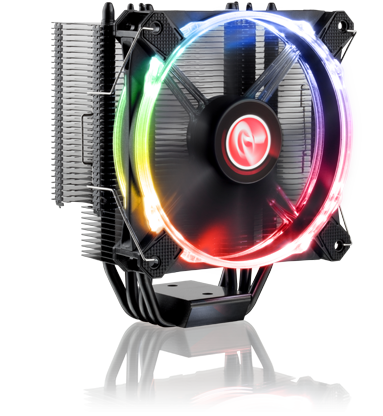An Understated Entrance
Form and Functionality
Uninstalled and powered off, the Leto Pro RGB is actually very plain, though undoubtedly very sleek. The all black heatsink really helps it in this regard, and I would love to see this become more common. Naturally, this cooler's A-Game will come into play when she is fired up, but regardless of that, I think Raijintek have made a great looking little unit here. Just below are the main specifications listed on Raijintek's website, some of which I have listed already:
- 120mm slim type CPU cooler – D:50mm x H:153mm.
- 4pcs 6mm Heat-pipe and C.D.C. - CPU Direct Contact design.
- Performing and silent 12025 RGB/LED PWM fan.
- RGB 4pin header, +12V G R B, compatible with most M/B system.
- RGB Y-cable and PWM Y-cable (PRO RGB version).
- Solder-free louver fin assembly to increase heat-pipe ventilation.
- Compatible with all modern sockets of INTEL and AMD at market.
- Anti-vibration rubber pads on all corners of fan to minimize movement and noise.
- Easy installation and user-friendly.
None of these listed specifications are really a surprise, however. 3 or 4 heat pipes is fairly standard for a cooler in the 30-40 USD/EUR price range, but I would admit that two fans are certainly not. As for some noteworthy points, two jump out at me. The first is the anti-vibration pads on the fans. Fans, especially at higher RPMs, can produce a very unpleasant vibration related 'hum' that easily makes itself heard over pretty much anything else in your system and can be incredibly annoying if your PC is just on in the background, but producing a near ungodly hum. My second point of note is the 'ease of installation' bit. This isn't so much a problem for smaller heatsinks, but easy install processes for any builder (new or old) has to be a good thing. The less blood and/or sweat I lose to cooler installation, the better. Whether it is actually easy to install is, naturally, up for investigation later.
I have deliberately not mentioned the RGB yet, because I feel as though it's... well, in the name? If you buy this cooler, I would venture a great draw of it is the fact you're getting 2x RGB fans for such a low price, and performance might well take second fiddle. Naturally, I do not yet know how it performs, so it might well prove to be a jack of both trades. Said functionality is provided by an RGB LED 4 pin cable that hooks into an RGB-Y splitter cable, that - in turn - finds itself in the appropriate spot on your mainboard. Now, I have to list this segment here with a major caveat, and it took me by surprise when testing this cooler.
Whilst the included cables for RGB functionality can plug into any appropriate 4-pin header on your motherboard, that header must have some level of RGB functionality in order to actually control what the unit's do. To put that in Layman's Terms, I mean that said header must be of the 12v RGB LED variety. If it is not, then your cooler will merely default to the white LED mode, and there will be no changing that 'on the fly.' This caught me out whilst writing this review, so whilst LED strip connectivity is fairly prevalent on even mid-end mainboards in 2018, the above specification is not exactly commonplace. Please bear this in mind if you choose to purchase this cooler.
So what about the fans? Well, 2 are included, naturally, but let's have a look at them. Anyone even half into this industry will know that a fan isn't just 'a fan', and some companies are quite literally solely focused on fans and cooling (Noctua springs to mind, oddly enough). Below are the listed fan specifications:
- Dimensions: 120 x 120 x 25
- Voltage Rating: 12V
- Speed: 800-1800 RPM
- Bearing Type: Sleeve
- Airflow: 56 CFM
- Pressure: 1.6mm H20
- Noise: 25 dBa (Max)
- Life Expectancy: 40,000h
Some of you may be wondering what all of that means. Well, below is a quick and dirty comparison of two fan models offered by two competitors, from BeQuiet and Cryorig. Below is a little table of comparison, so you can get an immediate idea of where the Leto stacks up. This may seem trivial, but the best-designed heatsink in the world would be nothing without some fans to go with it (depending on use case, naturally).
| Model | Speed (RPM) | Airflow (CFM) | Pressure (mm H20) | Noise (dBa) | Life Expectancy |
|---|---|---|---|---|---|
| Rajintek | 800-1800 | 56 | 1.6 | 25 | 40,000 |
| BeQuiet! | 1800 | 87 | 1.25 | 26.8 | 80,000 |
| Cryorig | 330-1600 | 80 | 1.65 | 25 | N/A |
As you can see, the fans are relatively well stacked up against the other. There isn't much in the 'noise' category to separate these units, which I could likely argue is a major factor in most people buying coolers. Airflow and pressure, however, are interesting. The BeQuiet! fan falls well behind the other in terms of static pressure but is fairly well ahead in terms of pure airflow. This is interesting, as a heatsink's ability to actually disperse heat relies on both the air being pushed away from it both rapidly and with force. As I do not have either the BeQuiet or Cryorig cooler here to test with, the above will serve just a fan comparison, and this unit will go up against the formidable NH-U12S from Noctua, and Fractal Design's much bigger S24. Perhaps not the fairest of fights, granted. Next, we will make the cooler do a little twirl, and then get onto what everybody is here for. The numbers.


